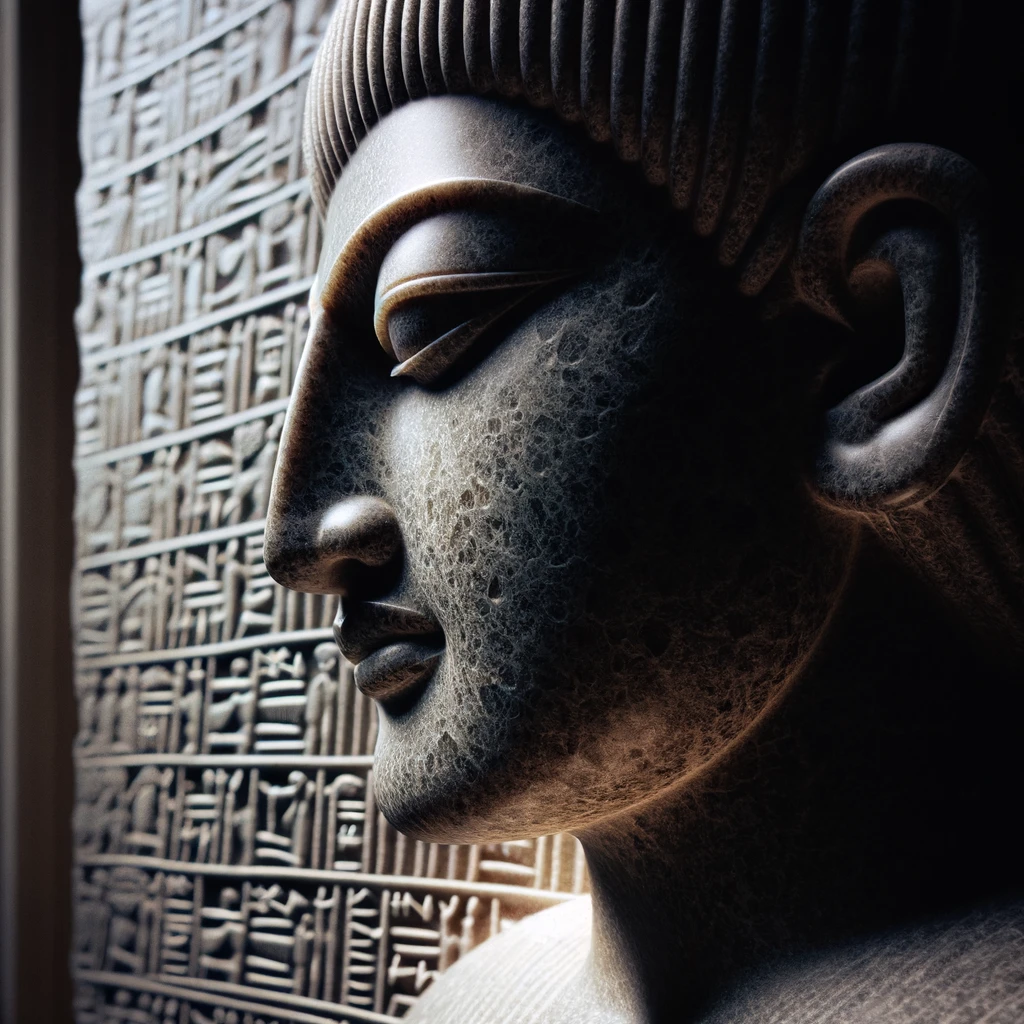Introduction
Picture yourself on the windswept plains, where the Tigris and Euphrates rivers carve their path through history. The sun beats down on ancient ruins, whispering stories of civilizations long past. This, friends, is Mesopotamia – a land where empires rose and fell, yet left behind an enduring legacy of artistic wonder.
From intricately carved figures frozen in eternal prayer to towering guardians adorned with wings, Mesopotamian art and sculpture offer a mesmerizing glimpse into a world both familiar and fantastical. It wasn’t just about beauty; these creations served as testaments to faith, chronicles of victories, and reflections of daily life.
So, prepare to be captivated by imposing stone figures, uncover the hidden messages within detailed reliefs, and marvel at the intricate craftsmanship of objects both grand and small. Are you ready to step into the vibrant world of Mesopotamian artistry? Let’s journey together through sculpture and symbolism!
Setting the Stage: The Fertile Ground of Innovation
Think of Mesopotamia not as a single kingdom, but as a stage where mighty empires took their turn in the spotlight. From the ingenuity of the Sumerians to the imposing grandeur of the Assyrians, each era brought its own artistic flavors. Yet, amidst the shifts of power, a shared pulse of creativity flowed through these ancient lands.
But let’s not forget the challenges! In a land where stone was scarce, Mesopotamian artists turned limitation into innovation. They transformed humble clay into awe-inspiring sculptures, coaxing intricate designs from precious metals, and infused semi-precious stones with meaning and beauty.
Their art wasn’t merely decorative; it was purposeful. Think of sculptures whispering prayers to the gods, reliefs boasting of a king’s triumphs, and even everyday objects adorned with a touch of magic. Their artwork was a powerful tapestry woven with belief, politics, and simply, the human desire to create.
Key Mesopotamian Artistic Periods
| Period | Approx. Dates | Key Art Characteristics | Example Artworks |
| Sumerian | 3500 – 2350 BCE | Stylized human figures, wide eyes, geometric motifs | Votive statues from Tell Asmar, Warka Vase |
| Akkadian | 2350 – 2150 BCE | Focus on realism, detailed musculature, royal portraitur | Victory Stele of Naram-Sin, bronze head of an Akkadian ruler |
| Babylonian | 1895 – 539 BCE | Animal symbolism, glazed brickwork, law codes with reliefs | Ishtar Gate, Stele of Hammurabi |
| Assyrian | 1895 – 539 BCE | Detailed battle reliefs, imposing winged guardians, palace decoration | Lamassu statues, Ashurbanipal hunting lions relief |
Sculpture in the Round: When Stone Takes Shape
In the hands of Mesopotamian sculptors, unyielding stone transformed into figures imbued with purpose and presence. Let’s delve into the captivating world of their three-dimensional creations:
- Votive Figures: Imagine wide-eyed statues, hands clasped in perpetual prayer. These weren’t portraits, but representations of worshippers forever offering devotion to the gods. Their stylized forms, with simple lines and exaggerated features, exude a timeless appeal.
- Royal Sculptures: Here, rulers sought to project an aura of power and divine connection. Their statues often appear imposing and unnaturally still, with stylized beards and symbolic adornments. These weren’t mere likenesses; they were carefully crafted statements of authority.
- Animal Figures: Lions guarding gateways, mighty bulls with human heads—real and mythical creatures alike populated the Mesopotamian artistic landscape. These figures served as protectors, embodiments of strength, and sometimes, even representations of the gods themselves.
Case Study: The Fascination of Gudea
Want to see these concepts in action? Consider the statues of Gudea, the ruler of Lagash. Crafted from rare diorite stone, they depict him with calm strength. Cuneiform inscriptions tell of temple construction and devotion to the gods. Here, art, politics, and faith intertwine seamlessly.
Reliefs: Narratives Etched in Stone
Mesopotamian artists were master storytellers, transforming walls and gateways into visual epics. In these bas-reliefs, where figures emerge slightly from the stone, we witness battles waged, rituals performed, and glimpses of everyday life immortalized.
- Technique and Purpose: Unlike a painting, bas-reliefs relied on carving away the stone, creating depth with light and shadow. These weren’t meant for quiet contemplation alone; they were bold declarations on temple walls or palace gates, designed to awe and inform the viewer.
- Hieratic Scale and Registers: Notice how figures aren’t all the same size? This is hieratic scale – important figures tower over others. Scenes were often divided into horizontal bands called registers, creating a clear visual narrative, like a comic strip from the ancient world!
- Masterful Storytelling: Let’s zoom in on a specific relief – perhaps the Stele of the Vultures, or the majestic Lamassu figures guarding Assyrian gates. We’ll dissect the action: victorious kings trampling enemies, priests leading elaborate rituals, or hunters chasing their prey. Symbols abound, adding layers of meaning for those who could decipher them.
Beyond the Monumental: Small-Scale Wonders
While temples and palaces showcased grand displays, Mesopotamian artistry also brought beauty and meaning to the everyday. Let’s explore these smaller, yet equally captivating treasures:
- Cylinder Seals: Imagine tiny stones intricately carved with scenes both mythical and mundane. These weren’t just for decoration; when rolled across wet clay, they acted as personal signatures or even told stories about the owner. They offer a fascinating peek into daily life and beliefs.
- Jewelry and Adornment: Mesopotamian artisans were masters of metalwork. Gold gleamed, precious stones shimmered, and elaborate designs transformed the wearer. Jewelry wasn’t simply a fashion statement; it signaled status or held protective amulets close to the heart.
- Decorative Arts: The vibrant hues of glazed bricks adorning the mighty Ishtar Gate weren’t an isolated example. From delicately painted pottery to intricately patterned textiles, Mesopotamian artists infused the everyday world with color and symbolism.
Think about it: even a humble bowl could depict a stylized animal or geometric pattern, making the ordinary extraordinary. Mesopotamia was a world where artistic expression found its way into every corner of life.
Mesopotamian Influence: Artistic Ripples Across Time
The empires of Mesopotamia may have faded into the sands of time, but their artistic legacy pulsates through the ages. Let’s trace some of those fascinating connections:
- Regional Impact: Think about the stylized figures and mythical creatures that later appear in Persian art, or how Greek sculpture adopted a focus on idealized forms. Mesopotamian influences were absorbed and reinterpreted by those who came after.
- Enduring Legacy: Can you see echoes of Mesopotamian art in modern movements? Some abstract artists drew inspiration from the simplicity of ancient forms. Meanwhile, the use of art to project power by rulers continues to this day.
- A Timeless Connection: While their techniques or materials might differ, the core motivations of Mesopotamian artists remain relevant. They sought to portray the divine, capture narratives of triumph, and find beauty in the world around them. This makes their work resonate with us even across the vast gulf of time.
Mesopotamian Art Techniques & Materials
| Technique/ Form | Materials Used | Description | Example Artworks |
| Sculpture-in-the-round | Clay, stone (diorite, basalt), metal (bronze, gold) | Free-standing, three-dimensional figures | Statues of Gudea, Ram in a Thicket |
| Bas-relief | Stone (limestone, gypsum) | Carved figures slightly raised from background | Stele of the Vultures, Assyrian palace reliefs |
| Cylinder seals | Semi-precious stones (lapis lazuli, carnelian) | Intricately carved mini-rollers for imprints | Scenes of daily life, mythology |
| Jewelry | Gold, silver, semi-precious stones | Elaborate necklaces, earrings, amulets | Royal tombs of Ur treasures |
Conclusion: The Enduring Allure of Mesopotamian Artistry
From the stylized gaze of votive figures to the imposing might of palace guardians, Mesopotamian art invites us on a journey through time. Their sculptures and reliefs showcase a dedication to detail, the power of symbolism, and the desire to leave a lasting mark on the world.
While their cities may lie in ruins, the artistic spirit of Mesopotamia lives on. It echoes in the works of later civilizations, inspires modern artists, and reminds us of the timeless human urge to create and express.
So the next time you encounter a museum artifact adorned with a cuneiform inscription or a stylized animal motif, remember the skilled hands that crafted it millennia ago. Their artistry transcends time, whispering tales of ancient empires and the enduring beauty of human imagination.
Additional Notes
Invitation to Further Explore
Has this journey ignited a spark of curiosity? Luckily, you can continue to delve into the wonders of Mesopotamian art in many ways:
- Museum Adventures: Experience the awe of standing before these ancient sculptures in person! Here are some museums with renowned collections:
-
- The British Museum (London) RESERVE HERE
- The Louvre (Paris) RESERVE HERE
- The Metropolitan Museum of Art (New York City) RESERVE HERE
- The Vorderasiatisches Museum (Berlin) RESERVE HERE
- Online Exploration: Can’t travel to a museum? Many institutions have fantastic online resources:
-
- The British Museum’s Mesopotamia collection database LINK HERE
- The Louvre’s virtual tours of their Near Eastern antiquities LINK HERE
- The Oriental Institute of the University of Chicago website LINK HERE
Let the journey continue! Whether you embark on a museum visit or a digital deep dive, the world of Mesopotamian art awaits your discovery.

